Gun Review: Cimarron Firearms 1866 Yellowboy Pawnee Carbine
While the 1860 Henry may be the rifle that started it all, it was the next version, the 1866 Winchester that takes the credit for the first true lever action saddle gun. The “Improved Henry” as it was originally called, was durable enough for use around the world and all over the western plains by friend and enemies of the US alike.
Cimarron Firearms has teamed up with Uberti to produce a special version of the iconic 1866 Winchester, celebrating the carbine’s use by the plains tribes; the Winchester 1866 Yellowboy “Pawnee”. It’s a true-to-life reproduction of a legendary piece of America.

Certainly anyone looking at the 1866 Winchester, or the “Yellow Boy” as the plains Indians had named it, would have immediately recognized the rifle as a Henry. The 1860 Henry rifle was groundbreaking. There were previous lever action rifles, but the Civil War use of the Henry is what launched the demand for the lever action repeating rifle.
The 1860 Henry’s weak link was the ammunition loading mechanism. Not only was it time-consuming, but the exposed magazine and follower were prone to breakage. Beyond that, that exposed follower made shooting off a rest challenging, as well as the need to move the shooter’s support hand out of the way as the follower came toward the receiver when rounds were expended. The result was the “Henry hop” handling method.
Fortunately for all of America — and specifically for Benjamin Tyler Henry — a shirtmaker and entrepreneur named Oliver Winchester saw the value of the Henry when other investors did not. Winchester bought the majority position of the Henry company and took control of the patents.
I can’t find when Nelson King began work for Henry or for Winchester, but in early 1866, Winchester made him superintendent of the factory. Later that same year, King would create the “Improved Henry” which would become known as the 1866 Winchester.
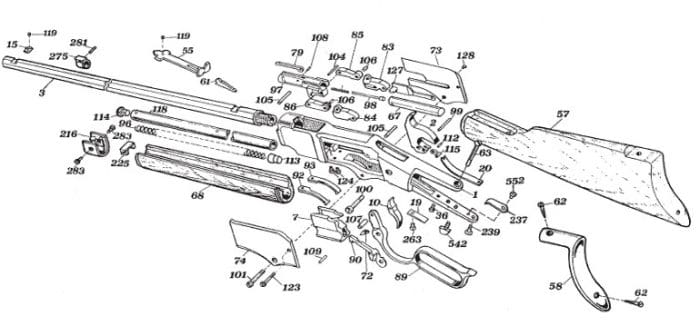
Looking at the design, King simply reversed the loading process. He created a hinged loading gate set into the receiver, and then instead of loading from the muzzle backward, he loading from the breech side forward. This allowed him to fully enclose the magazine, as well as adding a wooden forestock over the magazine. The result was faster and simpler loading, improved durability, and dramatically better handling. Unsurprisingly, the rifle was a hit.
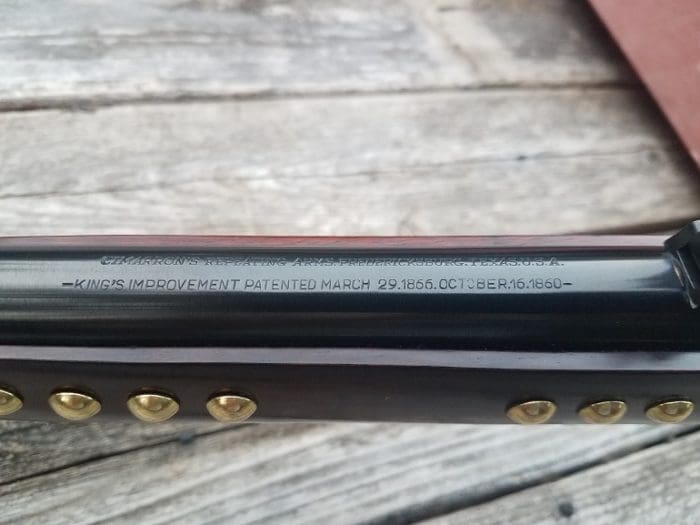
The early 1866 Winchester’s were marked, “Henry’s Patent – Oct 16, 1860/King’s Patent -March 29, 1866.” Later versions would be marked “Winchester Repeating Arms New Haven CT. King’s Improvement Patented March 29, 1866. October 161860-“.
It was a huge commercial success. At a time when the American population was less than 10% of what it is today, over 170,000 Winchester 1866 rifles and carbines were sold. Demand for the rifle extended long after more powerful lever action rifles existed, and it was made all the way up until 1898.
There were two original versions, a 24″ rifle and a 20” carbine. The smaller carbine, made for carry and use on horseback, outsold the rifle version by a margin of seven to one. It’s this more popular carbine version the Cimarron Pawnee is based on.

The toggle-linkage action of the 1866 looked much like the action of the previous 1860. The only thing that really changed was the ammunition loading mechanism, not how the rounds entered and exited the chamber.
Metallurgy improved, allowing for more powerful chamberings in the Winchester 1873 models, but the action didn’t change from the 1860 or 1866 models. It wasn’t until 1884, when Grey Bennet, then president of Winchester, asked one John Moses Browning to look at improving the design of the 1860/66 action.
Of course, that ultimately led to what would become the most lasting lever action designs, which were the combinations of the work Browning began in 1884 and the previous work he did for a falling block Winchester in 1979. The result would be the iconic Winchester 1886, and all the models that followed it.
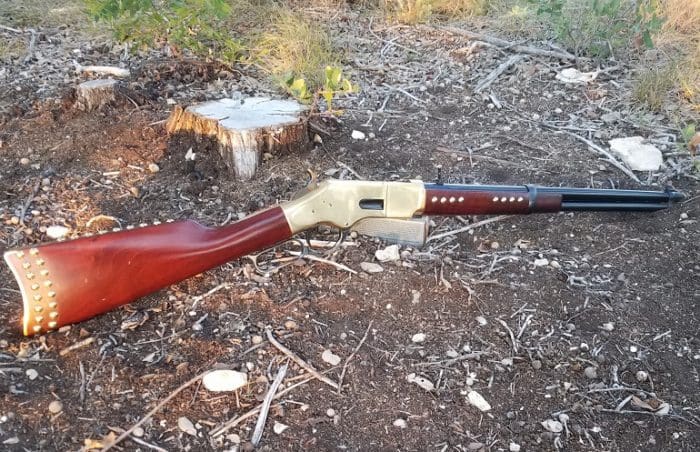
The Pawnee is a beautiful gun. With that gorgeous brass receiver, it’s hard for it not to be. If this gun looks at all shiny, don’t be fooled. These photos represent nothing close to the gleam this gun can obtain.
All of these guns are shipped with a plastic covering over the receiver. I get why, but still, the plastic sheets leave marks that need to be polished off in order to get the full effect of the beauty of the receiver. As I found out with the 1860 Henry, it’s worth 30 minutes of your time to take a rag with some metal polish to the brass receiver. You’ll be left with a mirror shine, to the astonishment of every person who sees it.
The wood on the Pawnee is a straight-grained walnut. I’ve complained before that Italian-made replica firearms frequently have better quality wood than most of their American made counterparts, especially for the price level. There is no fancy burl on this particular model, but I can’t find any historic photos with fancy wood grain in the 1866s either.
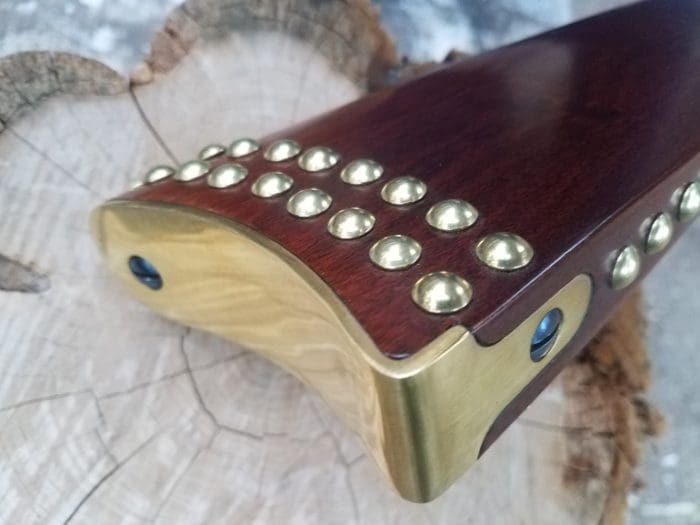
In the case of the Cimarron Pawnee, the stocks have been decorated with large brass tacks. For those of you who may think this is just kitchy nonsense, it’s very much a replica of how Indian tribes decorated their rifles. I had absolutely no difficulty finding multiple examples of 1860 Henry and 1866 Winchester rifles so adorned by natives plains tribesmen.
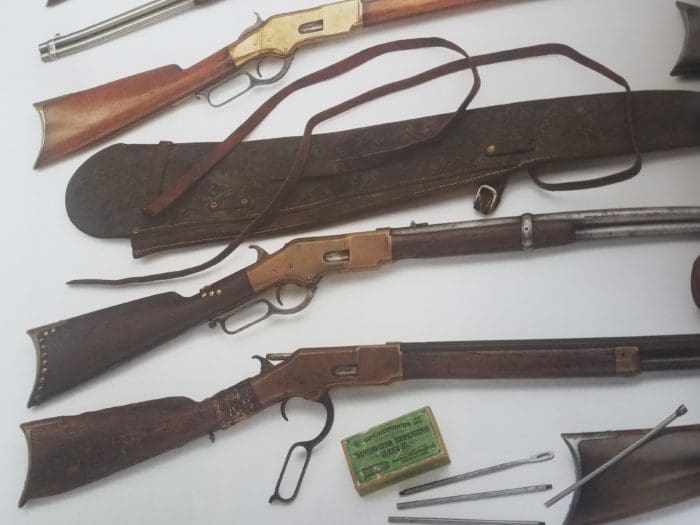
The name, “Pawnee” is an interesting choice for this model by Cimarron. The Pawnee were a southern plains tribe that often served as scouts for the United States Army, especially in the army’s war against the Pawnee’s traditional enemy, the Sioux.
It’s great to honor them with a fine weapon they certainly would have used and recognized. But the most famous brass-tacked rifle was actually used against the Pawnee by the legendary Oglala Sioux and appropriately named “Pawnee Killer.” Pawnee Killer placed a single brass tack into his rifle every time he killed a Pawnee. When he entered the Red Cloud reservation in Nebraska, he had over 100 tacks in his rifle.
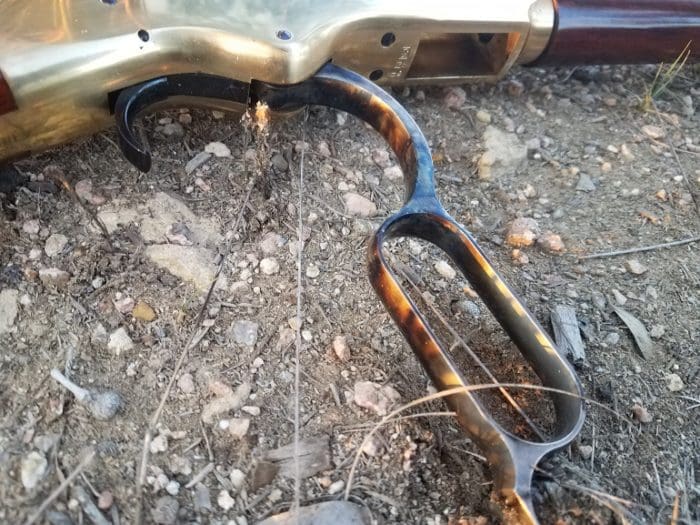
The hammer and action lever are case hardened and beautifully finished. It appears the originals were as well, just not this well colored or polished. You’ll find the hammer is deeply textured. I didn’t have any problem thumbing it back, or more importantly, getting a solid grip to lower it with bare hands or gloves.
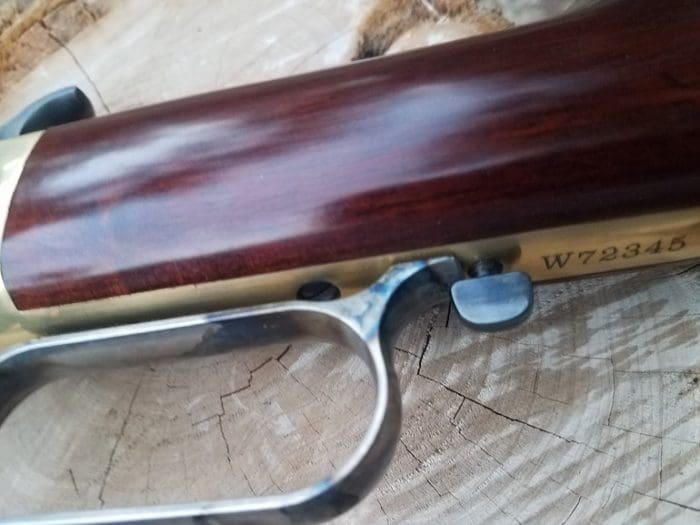
Just behind the action lever you’ll find a small tab, just as on the original 1860 Henry rifle. This tab turns to lock down the action lever. This is not a safety. The intended design has simply to keep the lever locked down so that a round wouldn’t be inadvertently ejected or miss-fed while the gun was being jostled on horseback. It simply serves to keep the action closed.
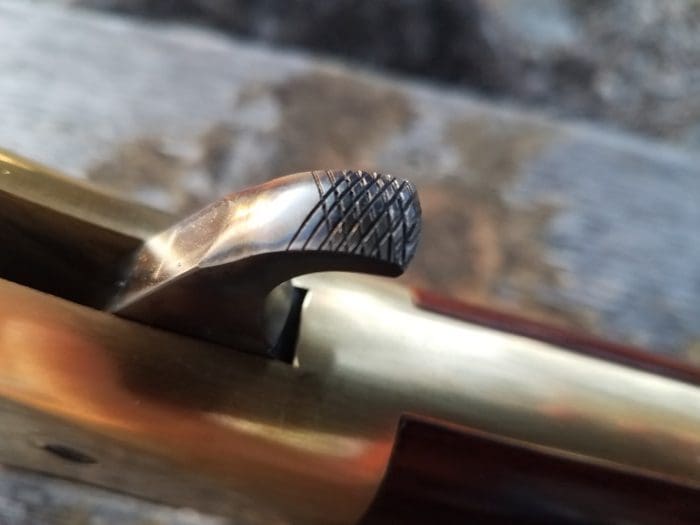
The 1866 also has a slight half cocked position, just enough to create space between the hammer and the firing pin. The only point of the half cock position is to keep the hammer off the firing pin in the case that the firearm is dropped or the hammer is hit.
I find it highly unlikely that the firearm could be dropped, even from horseback, in such a way that would have enough momentum behind the firing pin to cause a round to go off, but I could definitely see it being dropped on the hammer, or something striking the hammer hard enough to do so.
Like the other Uberti lever action rifles I’ve reviewed, the screws are nicely colored, and mostly are “timed” to a north-south axis. That’s a much appreciated touch, and one sadly forgotten on most modern firearms and completely ignored on all but the most expensive American-made guns. I was disappointed to see that not 100% of the screws on the left side of the receiver were so timed.

The smoothness of the action is just ok. If you’re used to the feeling of a Winchester 1886 or the ’94, this doesn’t feel like that at all. And it shouldn’t as there’s not “block” to fall. The action doesn’t spring open, but it moves smoothly through the process. There are no places to hang up, and with the fairly short round, I had no problem getting multiple shells in the air while shooting steel. It’s an easy, fun gun to shoot.
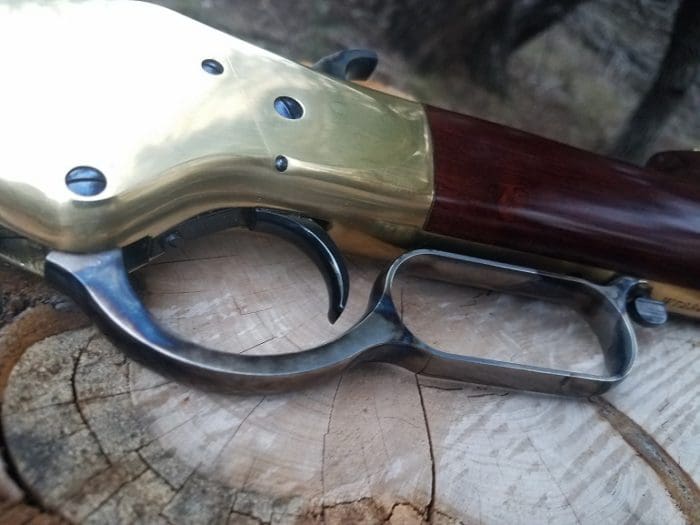
The trigger has a little bit of pre-travel and then breaks cleanly at just over 5 lbs. I have no idea what the original trigger weight was, but I’m betting it was something similar. For those of you wanting something lighter, there are smiths out there who can take it all the way down to one pound of pull.
The 1866 Winchester Pawnee comes in only one caliber, .45Colt, AKA .45LC. Although the .45Colt certainly existed during the same years the 1866 Winchester was produced, the rifle was never chambered in that particular caliber. As far as I can tell, although the factory would offer several models and would happily modify rifles for the customer, the only caliber ever offered was the same as the original 1860 Henry, which was the rimfire .44 Henry.
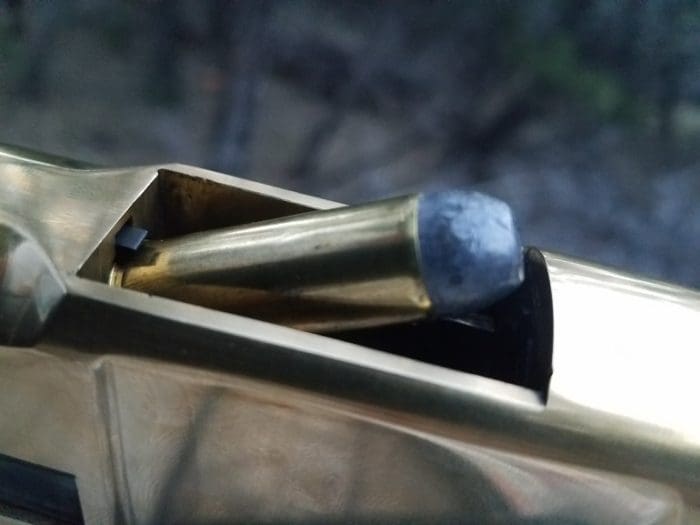
Out of a rifle-length barrel, this would have delivered about 560ft/lbs of energy at the muzzle. The .45Colt cartridge has incredible potential and can be loaded to deliver energy levels well beyond that of the .44 Magnum, but only in firearms built to handle that kind of pressure.
The original 1866 Winchester was not so built, and I don’t know if the modern reproductions are either. Most commercial .45Colt loads sold today are less powerful than the .44 Henry rimfire, but can be loaded to reasonably duplicate the external ballistics of the original cartridge. Still, like many of the other versions of the 1866 Winchester, I wish the Pawnee had also come in .44WCF/.44-40, since you can still find commercial loads that duplicate the original Henry cartridge.
At just over 7lbs, the Pawnee has very little recoil. I used a variety of different rounds and loadings, from recoil-reduced Winchester Cowboy Action loads, to rounds far more suitable for hunting and home defense. You can certainly feel the difference between the 200gr HPs and the 255gr SWC hunting loads, but none of them produce enough recoil to even move the muzzle clear of the target while shooting from the kneel.
The original 1866 “Improved Henry” had a reputation for reliability. Cimarron’s Pawnee lives up to every bit of that reputation.
I put 250 rounds through this gun in about a week’s time. I shot a box of the 225gr Winchester Super-X HP, a ton of the filthy 250gr Cowboy Action load, and 100 rounds of Blazer 200gr HP. Because I could, I also loaded up a few of my own 255gr SWC hard cast rounds that are going right at 1,000fps out of a 7 1/2″ Single Action Army and put those through the Pawnee.
Even with such a wide variety of overall lengths and projectile weights, I had no issues with reliability whatsoever. It also didn’t matter if I cycled the gun fast or slowly, and some lever guns have issues with a slow cycle. There were no problems loading, firing, or cycling at any time with any load.
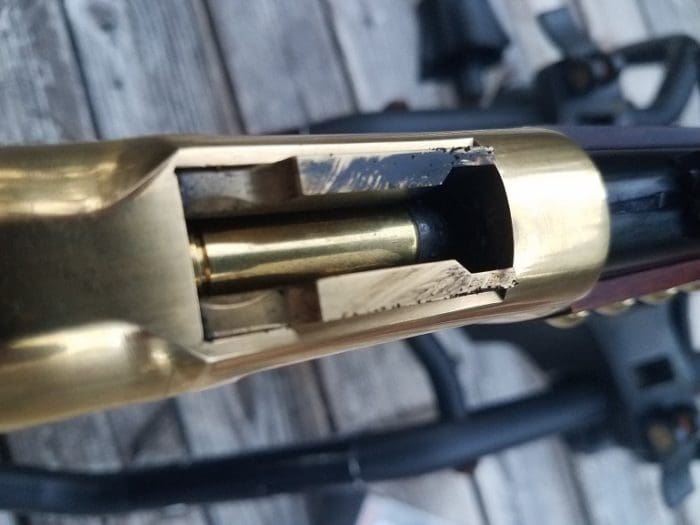
Like the original action, the Improved Henry is beautiful in its simplicity. There’s just not much to go wrong with it. No matter how dirty the receiver gets, it would be hard-pressed to actually stop the a round from ejecting or loading.
The Cowboy Action loads from Winchester are notoriously dirty, and still, when the receiver was completely fouled, it never missed a beat. I lubed the gun prior to shooting it, and never performed any maintenance on the gun at all, not even wiping it down until the review was over and I needed take some photos.
I have to stop being surprised by the level of precision I’m getting from these Uberti guns, but they got me again. I averaged 3″ five-round groups at 100 yards for four strings while shooting off a Caldwell Stinger shooting rest with the Winchester Cowboy Action 250gr flat-nosed lead round. There was a fairly wide distribution, with my smallest group being 2 1/4″. The Blazer 200gr JHP scored more consistently, but slightly wider, with a 3 1/2″ average using the same criteria.
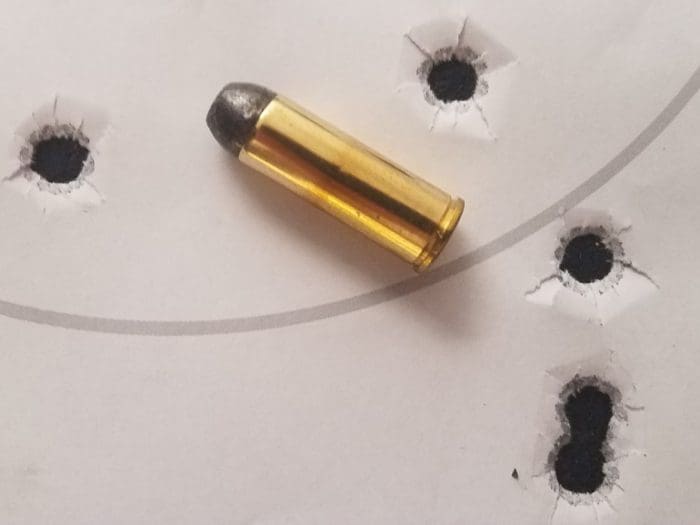
The gun itself is probably capable of more precision that that with better eyes behind it, but that’s still well outside of the range I would shoot any game other than a pig or coyote at with the standard .45 Colt round.
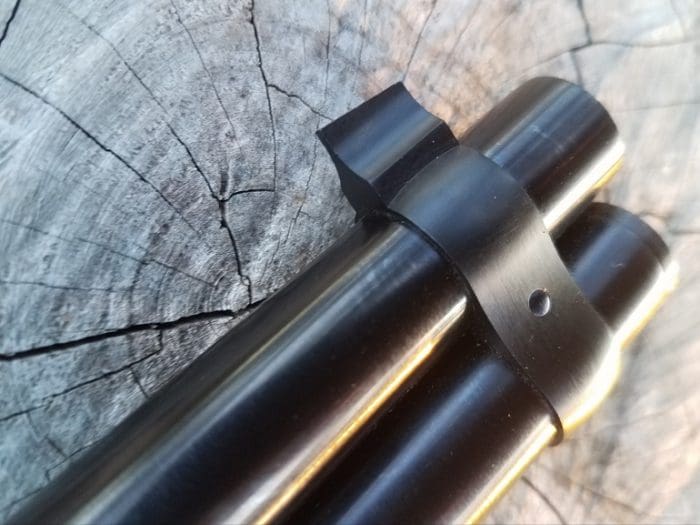
Part of that precision is sight set up. The front sight is a long triangular post, ending in a narrow, sharp point. That front sight is fixed via a barrel band around the barrel and magazine tube. The rear sight is drift adjustable, and has what is in essence three different apertures. For short range work, you’ll find a simple low notch. Flip that back and down and you’ll find a two part aperture.
One is wide circle with a slightly higher notch than the first one at the base. That notch is very small, and the tip of the front sight fits tightly within it. It is worthless for low light shooting, but perfect for precision. The big circle above it is the exact opposite. A silhouette targets fills the circle at 50 yards, and is centered inside of it at 100 yards, as in the photo below. On top of that sight is another tight notch.
With the Winchester Cowboy Action Load, I found the first position of the sights great for between zero and 50 yards, with the bottom of the raised aperture good for the 100 yard mark. I have no idea what the tallest mark is at, but I’d guess around 200 yards. That round drops pretty fast, and you’re really arcing it in at that point.
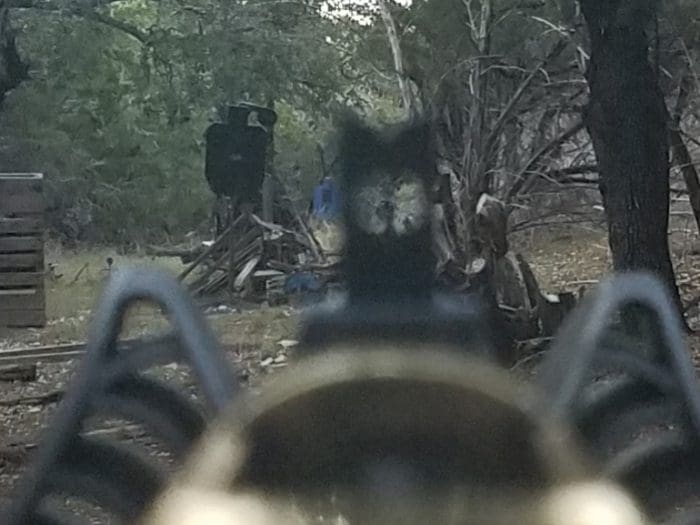
Although effective, I can’t tell whether or not these sights were typical of the originals. The front sight seems to be the same as the most common models available, but most of the original rifles and carbines I can find have full elevator style rear sight. That said, I can find examples of many different sight set-ups in photos of historical rifles. Maybe this is one of those, but I can’t find another one just like it.
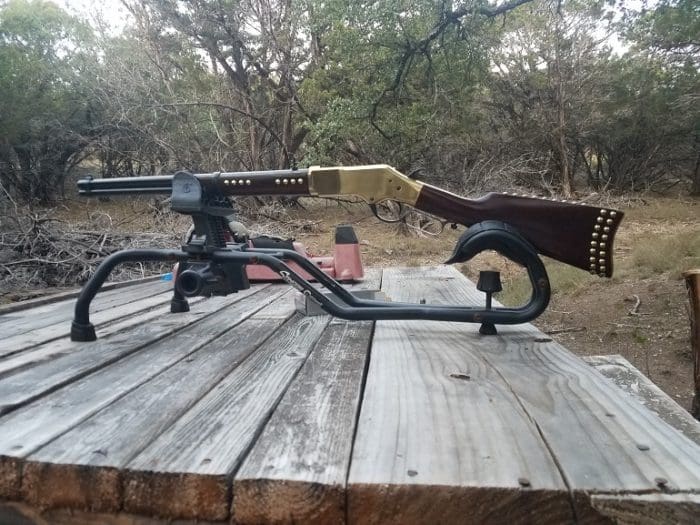
I love that Cimarron made an “Indian” gun and a good one. After all, if anyone depended on a quality rifle, no matter what side of the conflict they were on, it was the horseback Native American. The fact is that these men immediately recognized the value of the 1866 and did everything in their power to obtain and keep them, exactly like US soldiers and civilians did. The 1866 Winchester Yellowboy Pawnee pays tribute to an amazing time in our nation’s history, when the land was still wild, and danger was everywhere, for everyone.
If you’re interested in purchasing an original 1866 Winchester, since so many were made, serviceable originals are fairly easy to find. There were also many different models of the 1866 made available, with quite a few different options available from the factory. All of those variables make the cost of the originals vary widely. Still, you can find a shootable original today for around $5,0000, with prices ranging all the way from $4,000 to well over $20,000 for rarer models.

For this review, I leaned heavily on two books, Winchester Rifles by Martin Pegler and Age of the Gunfighter by Joseph G. Rosa.
Specifications: Cimarron Firearms Winchester 1866 Yellowboy Carbine “Pawnee”
Caliber: .45 Colt
Barrel: 19″ round, 6 groove 1:16RH twist
Receiver : Brass
Buttplate: Brass
Stock: straight grained walnut with brass tack adornment
Lever: case hardened
Magazine Capacity: 10+1
MSRP: $1,363.70
Ratings (out of five stars):
Style and Appearance * * * * *
Cimarron was going for a particular aesthetic with this model, and they nailed it. The brass receiver, quality wood, and the case hardened lever and hammer look great. The wood-to-metal fit is quality, and the colored and the (mostly) correctly timed screws are a nice touch.
Historic Accuracy * * * *
I had to take a star off for the rifle not being offered in the original caliber or in a caliber close to the original, like the .44-40. There are several other 1866 models by Cimarron that offer that caliber. This one, oddly enough, does not. The rest of the gun is dead-on, and matches the style and details of multiple examples I can find in books and up for auction.
Reliability * * * * *
It shot anything I could load in it, and I ran a wide range of in-spec rounds.
Accuracy * * * * *
With 3″ groups at 100 yards from a carbine-length pistol caliber rifle, I’d say that’s as good as my eyes can possibly shoot. A great sight set-up certainly helps.
Overall * * * * 1/2
The only thing I can really count against this rifle is it not being offered in a caliber closer to the original, like the .44-40. I was going to take another half a star off for less-than-gorgeous wood, but this is a reproduction gun after a specific niche in history. I can’t find any examples of those original guns with fancier wood than this one, so it gains points there. Obviously the accuracy and reliability are outstanding. I can’t find this exact sight set-up, but I can find so many others that I’m not sure it wasn’t offered, and it works great. All in all, Cimarron has made an excellent gun that’s beautiful, full of history, and a ball to shoot. Plus, it’s just cool to have a “cowboy” gun that’s all set up for the Indians.

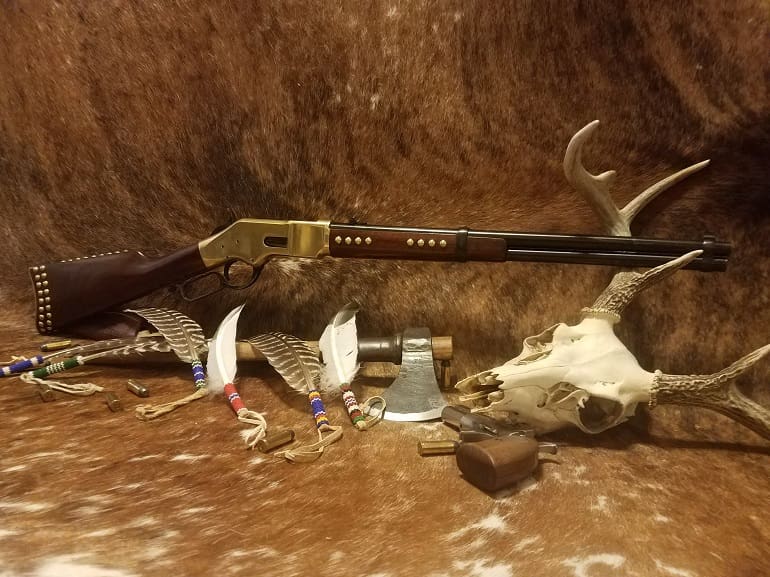



Those brass tacks look like crap. Otherwise I like it.
I second that. Nice rifle , the tacks would have to go.
Agreed. Looks like the upholstery tacks in a Goodwill-reject secondhand sofa. Without those, I’d pick one up in a second. (The rifle, not the sofa.)
My grandmother had a chair that looked like that.
I have a ton of those exact tacks and an early 1960’s Winchester 30-30 (mint). Maaaaaaaaaaaaaaaaaaaaaaybe……I should just leave well enough alone. Now, some Iron Maiden heavy metal spikes on a dark black stain, hmmmmm
The tacks and the look connects to the Native Heritage are the WHOLE POINT of the rifle, what don’t you understand? You can buy the same model in the traditional look but that is the type of rifle my people the Chiricahua Apache carried against the US Cavalry among Sharps and other weapons they took off the soldiers. If you don’t like the Tacks then go get the other models.
i’m not native american but i fell in love with this gun the minute i saw it. the tacks, and the distinctive look they provide are what make this gun stand out from the crowd. this or the taylor $ co. 1873 comanchero is going to be my first of many lever action guns. i recently became obsessed with lever guns and this might be my favorite. you native americans have always had many talents and gifts. a flair for style being one of those
Mr Griffin
In response to all your posts, may I respectfully respond to all your major points. First, the brass tacks present in the Uberti stock representing native American’s customs are simply a matter of personal taste as to whether you approve of them or no. Personally, I like their historical reverence and the totally unique look they give the rifle. Would I put the brass studs in other lever action rifles I own. No…they don’t belong there.
Secondly, you seem to have a strong objection to the studs because they represent barbaric behavior by the Indians. No sense trying to dispute that so many tribes did engage in such things, but consider those times. Constantly under attack by other hostile tribes, not to mention the atrocities committed against them by the U.S. Army… what would you expect them to do… turn the other cheek?
Perhaps a little known fact is that the U.S. government encouraged the slaughter of the buffalo so as to deprive the Indians of their main food supply. “ Starve ‘em into submission” was the motive. Should we place hateful symbols on our present currency to celebrate that? Obviously not. Terrible mistakes in our past… just like slavery.
The Maori’s ? Having been in New Zealand and studying them, I found their weapons of war in the Auckland museum remarkably similar to other South Sea islands inhabitants. All of them were cruel and incredibly savage… all of them. The Vikings, the Romans, and on and on- condemning and distancing oneself from history? How many tourists each year can’t wait to visit the Coliseum?
Cool…a rich jeweler I deal with has one of these(a real one) in his vault(and a hell of a lot of other lever guns and “other” goodies).
5,0000? How much is that in US dollars?
Sorry, felt like picking a nit.
It’s fivety-hunderd. Everybody knows that.
Funny, I always thought the tacks were used to wrap stocks in leather or game skins. Didn’t know it was simply the tacks as decoration.
Anyway, nice review. But you definitely missed a pun opportunity to get down to brass tacks.
“Most commercial .45Colt loads sold today are less powerful than the .44 Henry rimfire, but can be loaded to reasonably duplicate the external ballistics of the original cartridge.”
Commercial .45 Colt,perhaps however any 45 colt cartridge loaded with 33 to 35 grains volume of 2 fg. black powder and a 250 grain bullet will more than readily best a 44 henry flat cartridge out of any 66 or 73 rifle. The difference in the receivers of the original rifles and Uberti’s reproductions is the originals were made of gun metal and Uberti uses brass in it’s construction.
Thanks for the great review and thanks for including all the history in the guns and particularly the “Pawnee killer” that was wonderful thank you.
The History part about guns and their use as what I’m interested in not necessarily calibers for the manufacturer. The end-user of the guns that’s where the history comes from appreciate acknowledging that.
And I do like how Native America Indian tribes decorated their guns. I’m actually considering doing that to the Henry rifle that I own right now.
I will check out your reference books!
Good job JWT.
The mention of Joseph G. Rosa is a big favor to those that have not read his work
Thanks, I’ve mentioned his work in several reviews now. His book, Age of the Gunfighters is without a doubt my favorite historical reference.
Ruin a beautiful rifle stock with big round headed tacks? No no no no no no no no!
those brass rivets are ugly as hell. looks like something you would see in a drug dealers house or something. just gawdy. who the hell bedazzles a fucking gun?????
TTAG needs a like button.
Who bedazzles gun like this? Read the review. The plains tribes decorated their guns exactly like this. That’s why this one is decorated that way. It’s a reproduction gun that’s historically accurate.
So you’re replicating marks made by Indians who murdered other Indians to keep track of their score. Great.
Now you get it.
I got it the first time. I liken it to people today who practice the Maori Haka. The Maoris were an evil people who went through life massacring other tribes and committing genocide. Remember, the Maori invaded the peaceful Moriori, and after initially murdering 20% of their men, women, and children, enslaved the rest and over the next generation raped, murdered, and cannibalized 95% of the tribe of 2,000. The Maori have a long history of massacres and cannibalism, yet people today glorify their history by practicing their war dance and that’s somehow supposed to be an homage to their noble history of rape and murder.
Might as well place Nazi symbols on your guns, celebrate the murder of Jews, gypsies, Serbs, Poles, homosexuals, and the handicapped, although I suppose it wouldn’t fit an older history piece like this.
/rant
You think the brass tacks are the same as Nazi swastikas?
Now I’m really looking forward to the Maori Carbine review…
Eh… Chill out a bit. Pick an ethnic group — any group, doesn’t matter where or when — and you can pin some horrible things to it. (That’s the basis of the SJW cult, btw.) You can also find things to admire about that very same group.
The point is not has any group done something wrong (although arguably some have been worse than others), it is celebrating it with revival memorabilia. Why add these tacks? As I asked previously, would you add Nazi swastikas to your guns to pretend it was a WWII gun or to imitate it because it was cool? Is that the kind of stuff you find fun?
Societies condemn the bad things they’ve done in the past, not celebrate them.
Btw, I’m no SJW. A confrontation between them and me wouldn’t be pretty.
Ing, so tell me, you said that you personally can find things to admire about the Nazis and Maoris. The entire Maori society was based around rape, slavery, murder, and cannibalism. Tell me, what can you admire about them?
What can you admire about the Nazis?
“Societies condemn the bad things they’ve done in the past, not celebrate them.”
You do realize that’s the exact logic the Leftists use against us, don’t you? 😉
wow, lighten up man. first of all this is a gun, (which is an instrument of war) and these weapons have been used historically to bring death and suffering to countless people. if you’re worried about negative symbolism such objects are associated with, maybe you should avoid gun collecting and find a new hobby. do you feel the same way about traditional looking model 1973 lever guns? i’m pretty sure tens of thousands (at the very least) of innocent native american men, women, and children died in agony from a bullet fired out of
“the gun that won the west”.
some of us like to celebrate the positive traditions and history of different cultures and races instead of dwelling on the negative aspects and/or events. i’m proud of my country and all the good it has done in the world even if acknowledge the sins of our past. there isn’t one culture or races in the history of the world with clean hands and no shameful moments. it’s very nihilistic to focus on the evil, violent acts instead of the heroics and bravery in people.
the nazi’s and soviets regimes were clearly evil without any redeeming qualities i can think of. i am a romani (gypsy) who was raised by a traditional gypsy father and a jahovahs witness mother. i’m not a fan of the nazi’s or soviets by any stretch of the imagination. i however don’t want to shame every german person for that terrible time in their past. i’m sure they both have many admirible hero’s in their folklore and cultures. i can even understand why some people are fascinated with nazi memorabilia and not just assume they approve of the evil acts sought out by those genocidal monsters.
i really am concerned about peoples obsession with social justice and righting every past wrong. none of us are perfect and shaming people doesn’t fix anything, it just makes you and everyone else miserable. also when you try to force everyone to think the way you feel is morally correct through censorship, you will eventually become as evil as the monsters you despise. maybe the 1866 pawnee isn’t your cup of tea, but it’s a cool looking gun in my book. step down off your soapbox and maybe you’ll be able to enjoy things instead of looking for a reason to hate.
jwtaylor, you're celebrating the murder of people who are somehow different than you and you don't see the difference? You are one twisted individual. I hope you are not in law enforcement.
So that’s a yes then. You think brass tacks are the same as Nazi swastikas. Your ridiculous opinions are now irrelevant.
JWT didn’t put the tacks in the stock, he just reviewed the damn rifle. Sheesh man,,wtf?
And I own several firearms with swatsikas intact, they have a relevant historical value. Doesnt mean I “celebrate” Nazis.
Most native Americans used the tacks to decorate their rifles, not to show how many Pawnee they killed.
Damn man, you’re getting all triggered, jumping from decorations on a repro rifle to cannibalism. That’s a pretty hard stretch dontcha think?
And the “hope you’re not in law enforcement” comment, kinda shows that you may be a closeted SJW.🤔
Quite a few Native Americans decorated their guns with tacks. It was a cultural thing, just like the their love of little beads. If you go to any western museum worth its salt you will see examples of Indian firearms with tacks and some examples with rawhide fixing cracked stocks and such. There is some great examples in the museum in Douglas Wyoming. The brass tacks were the real west whether you like it or not.
Comparing the plains Indians to Nazis’ is really over the top. Sure they at times did some brutal things to the soldiers and the settlers, but really have you ever read what the soldiers did to the Cheyenne and Arapaho at Sand Creek or at Pine Ridge? At Sand Creek Colorado the soldiers attacked a peaceful band under Chief Black Kettle who was flying an American flag. Most of the young men were hunting in Western Kansas. The “soldiers” butchered 170+ people the majority of whom were women, children and old men. They then came back to Denver and paraded the body parts around acting like they were heroes.
What did the white eyes decorate their rifles with after they massacred and committed genocide on thousands of Native Americans? I am 1/4 Cherokee and the white man and the black man killed innocent Native Americans just for their land and the gold that was on it, then the Yankee government started paying money to butchers for bringing in Native American scalps! Read your other real history books and do a little research and don’t take the word of the fake history books you read and were taught in school! Hundreds of different Native American tribes were destroyed to extinction by the white man! I figure they can decorate their damn rifles with anything they want to! Brass tacks were not only used by Native Americans to decorate their weapons, the white man also decorated their knives, tomahawks and Rifles with them! It was a fahion at the time!
I’m going to “tack” my Yellow Boy one of these days. On a trip to Santa Fe, in this obscure antique shop for which Santa Fe is famous, I found a collection of tacks dating back to the Civil War.
I also had my 1866 converted from .44 Special to .44 Russian — basically replacing the .44 Special carrier with a special carrier with a block to allow the gun to run the short Russian cartridge (the modified carrier was originally made for the CAS .45 Cowboy Special cartridge, which is pretty much the same length as the Russian).I can shoot loads that pretty accurately duplicate the .44 Rimfire. The .44 Russians from Black Hills, BTW, are amazingly accurate as well as being powderpuff loads.
Neat.
JWT, try to get a new one from Winchester to compare, it would be interesting.
I was kind of surprised, but they are making 1866s, in 20 and 24″ barrels, in .38 Super, .44-40 and .45 Colt. They also produce the famous 1873 and of course the John Browning 1892, among others. Some purty fancy ones to boot.
“the modified carrier was originally made for the CAS .45 Cowboy Special cartridge”
That would be Adirondack Jack and Happy Trails/Bill English’s compilation.
The original test carrier was invented and milled by Jack out of PVC and went into my 66 and 73 to prove the idea. When Hap milled the brass carriers and improved the spring and attachment to the side of the carrier and wa la the Smith Shop carrier was on it’s way to allowing numerous older shorter than 45 colt/44-40 length cartridges fit in Uberti rifles.
Dang, I want one of these so bad…
Needs moar rivets.
No, srsly. WTF is with that?
n/m. read up. But still. Bleh.
I’ve always read that these guns were more reliable if they were chambered in pretty much anything other than .45 Colt, since it has a smaller rim than other revolver cartridges. Since there seems to be a few here in the comments that have considerable experience with these types of rifles, is there any truth to this?
If you love to wear vests? so get this amazing Red Puffer Vest which is a favorite of all girls and it is the most-rated and most selling outfit in our store, shop now because the stock is limited.